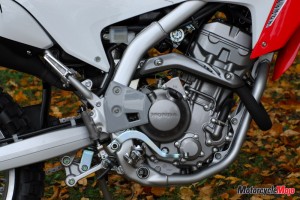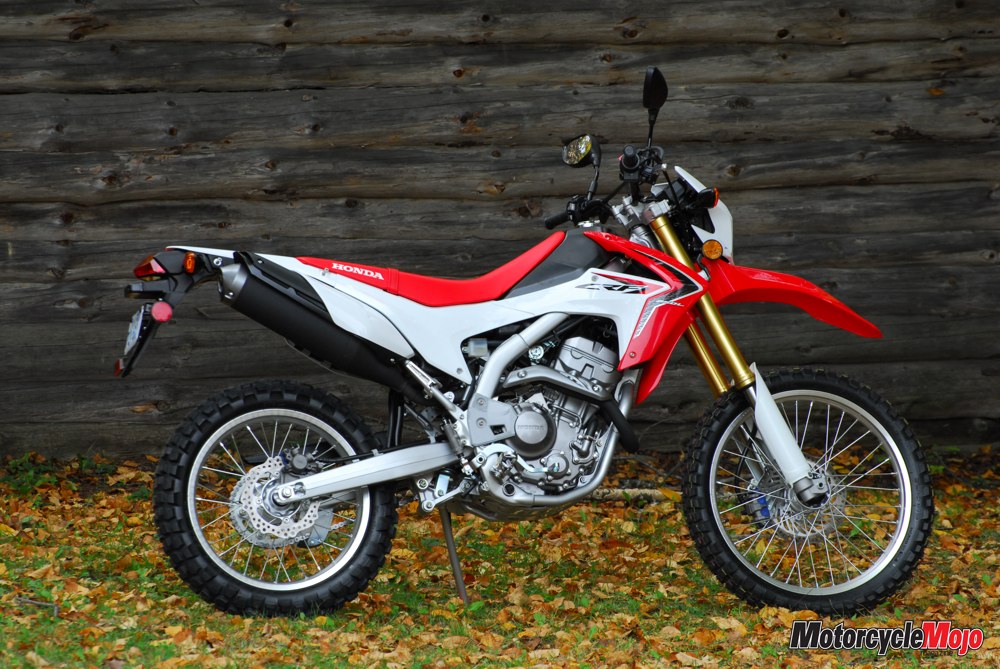Honda has a 40-year history of building 250 cc, off-road motorcycles, and all of that knowledge comes to the forefront in the new CRF250L for more fun on the pavement, gravel and trails.
Is it really fair to call a 250 cc dual-sport a play bike? After all, once you get off the pavement and into some dirt with a modern 250, it becomes painfully apparent that what can seem small on the street can deliver a pretty substantial punch of power on the trail.
All of the big-four Japanese manufacturers make a small-displacement, dual-sport motorcycle, although this segment of the motorcycle market seems to be the last to receive major upgrades. But hot on the heels of Honda’s groundbreaking CBR250R streetbike comes the CRF250L dual sport.
Based on the same engine that is used in the CBR250R, the CRF250L replaces the long-running CRF230L and introduces a vast array of upgrades in what is essentially a brand-new motorcycle from the ground up. Because of the different riding style a dual-sport requires, some modifications to the driveline were needed for the dirt. The transmission gears are stronger for off-road abuse, and the gear ratios have changed for additional lower-end grunt, while the camshaft has been swapped out and the general engine tuning and setup has been modified for more bottom-end torque.
 Operating and feathering the cable-operated clutch is an easy, two-finger operation that conveniently allows the remaining two fingers to hold onto the hand grip when bouncing over rocks and roots in the forest. The six-speed transmission shifted smooth as butter with light effort. Once, as I stood on the serrated pegs during a stretch of technical, single-track trail, my shift lever hit a large rock and shifted the transmission into neutral while I was accelerating. Recovering quickly, I jammed it hard back into first and took off before the person behind me ran into my rear tire. When we stopped at Trail Tours, our base camp in the Ganaraska Forest, I borrowed a couple of adjustable wrenches and straightened my shift lever back to normal. The trauma of that episode had no ill effect on the transmission whatsoever.
Operating and feathering the cable-operated clutch is an easy, two-finger operation that conveniently allows the remaining two fingers to hold onto the hand grip when bouncing over rocks and roots in the forest. The six-speed transmission shifted smooth as butter with light effort. Once, as I stood on the serrated pegs during a stretch of technical, single-track trail, my shift lever hit a large rock and shifted the transmission into neutral while I was accelerating. Recovering quickly, I jammed it hard back into first and took off before the person behind me ran into my rear tire. When we stopped at Trail Tours, our base camp in the Ganaraska Forest, I borrowed a couple of adjustable wrenches and straightened my shift lever back to normal. The trauma of that episode had no ill effect on the transmission whatsoever.
While the single front-brake rotor had a very thin contact area from the brake pads, the front brake worked well and offered good feedback, even in loose dirt. The rear was also quite effective on pavement but was easy to lock up in the dirt. Handy for sliding into corners.
With a generous ground clearance of 255 mm (10 in.) and long suspension travel on both ends, it easily soaked up everything that we threw at it in the bush. I thought the Showa 43 mm inverted fork seemed a little soft on the road, but it worked perfectly on the trails and is well suited for the casual dual-sport enthusiast. The front suspension is not adjustable, but the rear monoshock is adjustable for spring preload. With substantial ground clearance comes a tall seat, and at 875 mm (34.4 in.), it’s a stretch to throw a leg over, although it tapers at the front, allowing me with my 32-inch inseam to touch terra firma with tippy toes.
A few days before our ride in the Ganaraska Forest, a big-bore, dual-sport rally badly chewed up some of the trails, to the point that some sections were 30 cm of very soft, motorcycle-stopping sand. While the 250s had enough power to pull themselves out of the fine powder, the fairly aggressive DOT trail knobby tires got bogged down. Once in the soft stuff, our legs came down for balance while we powered out of it.
In true Honda fashion, the CRFs are very quiet, which is nice when running through the forest . . . but is it possible to be too quiet? At one point we came across a group of five horses and their riders, all startled by the appearance of our six bikes as we rounded a corner; they hadn’t heard us coming. They told us that if they had heard us, they would have moved over to the side, off the trail.
Most of our time was spent on trails, but one of the beauties of a dual-sport motorcycle is the ability to ride on the road in order to get to the trails. The CRF250L is well rounded in its design, as it also makes an excellent road bike. The seat is wide and comfortable, and the hands and feet seem to naturally fall into the proper places. I did find, however, that when I stood up on the foot pegs, the handlebar seemed a little low and I felt excessively bent over. This made it awkward when manoeuvring tight, single track, but an easy fix would be to add taller bars. For comparison, I rode a CRF230L with taller bars, and it made a big difference to my standing position. Unfortunately, the first part of my ride was single track, and my initial impression was that the bike was too small to be enjoyable, but after being on it for a whole day in a variety of terrain, and once used to it, my thoughts changed and I really enjoyed my time on it. The liquid-cooled engine is a jewel; the throttle is responsive, the fuel injection never skipped a beat, and I felt no engine vibration, thanks to the engine’s balance shaft. It’s a fun, agile bike that should appeal to a wide range of riders.
At $4999, the CRF250L offers an outstanding bargain in a very competent, modern package. I wasn’t in a position to determine fuel efficiency during my day in the bush, but if it is anything like its street-going counterpart, the CBR250R, it should be in the 3 L/100 km range as we determined when we tested it (Nov. 2011).
A big thanks to Steve, Bruce and Adam at Trail Tours for not getting us lost in the Ganaraska Forest’s 11,000 acres and hundreds of kilometres of trails.
| The Basics | |
| List Price | $4,999 |
| Warranty | 1 year – unlimited distance |
| Company URL | www.honda.ca |
| The drivetrain | |
| Engine Type | Liquid-cooled, four-stroke, DOHC single-cylinder |
| Displacement | 249 cc |
| Power (claimed) | N/A |
| Torque (claimed) | N/A |
| Bore and Stroke | 76 mm × 55 mm |
| Compression Ratio | 10.7:1 |
| Fuel Delivery | PGM-FI electronic fuel injection, 36 mm throttle body |
| Transmission | Six-speed |
| Final Drive Type | #520 chain; 14T/40T |
| The essentials | |
| Front Suspension | 43 mm Showa inverted fork |
| Rear Suspension | Pro-Link Showa single shock with spring preload adjustment |
| Wheel Travel | Front: 250 mm (9.8 in.) travel, Rear: 240 mm (9.4 in.) travel |
| Brakes | Front: 256 mm disc with dual-piston caliper, Rear: 220 mm disc with single-piston caliper |
| Wheelbase | 1445 mm (56.9 in.) |
| Rake and Trail | 27.6 degrees/113 mm |
| Tires | Front: 3.00-21, Rear: 120/80-18 |
| Weight (wet) | 145 kg (320 lb.) |
| Seat Height | 875 mm (34.4 in.) |
| Fuel Capacity | 7.7 litres |
| Fuel Economy (observed) | N/A |
| Fuel Range (estimated) | N/A |






























